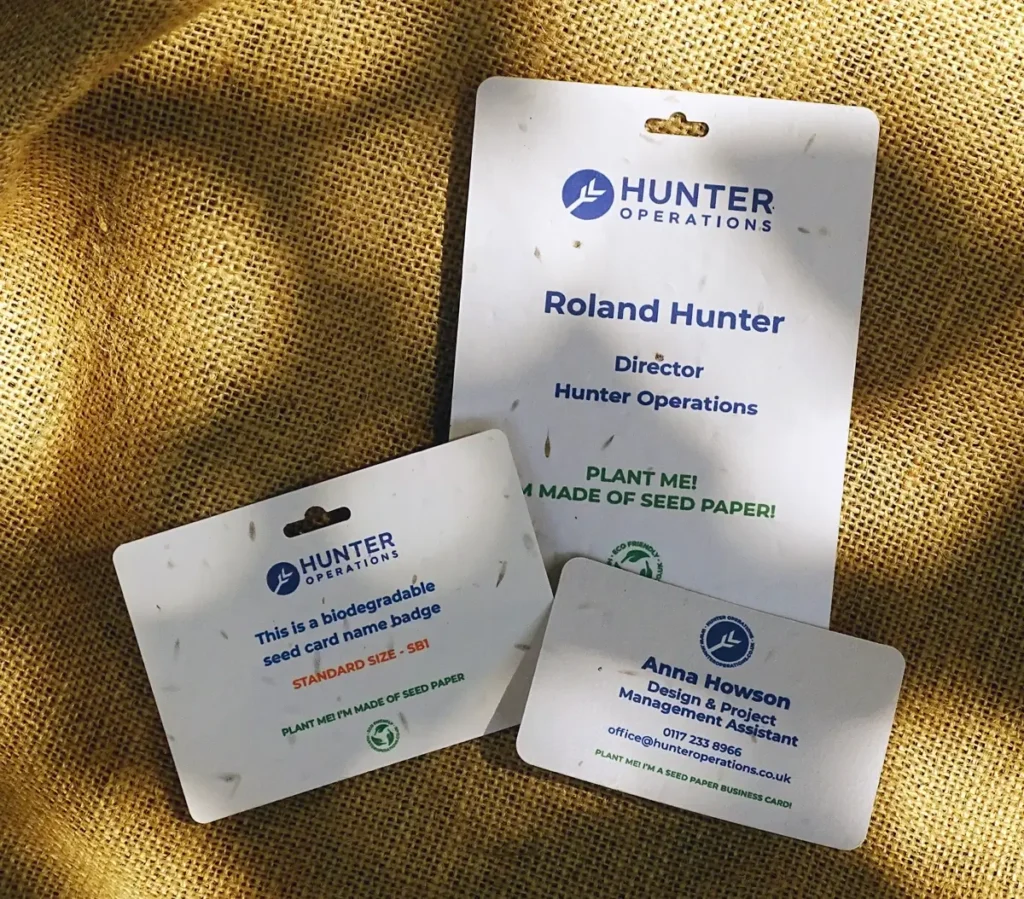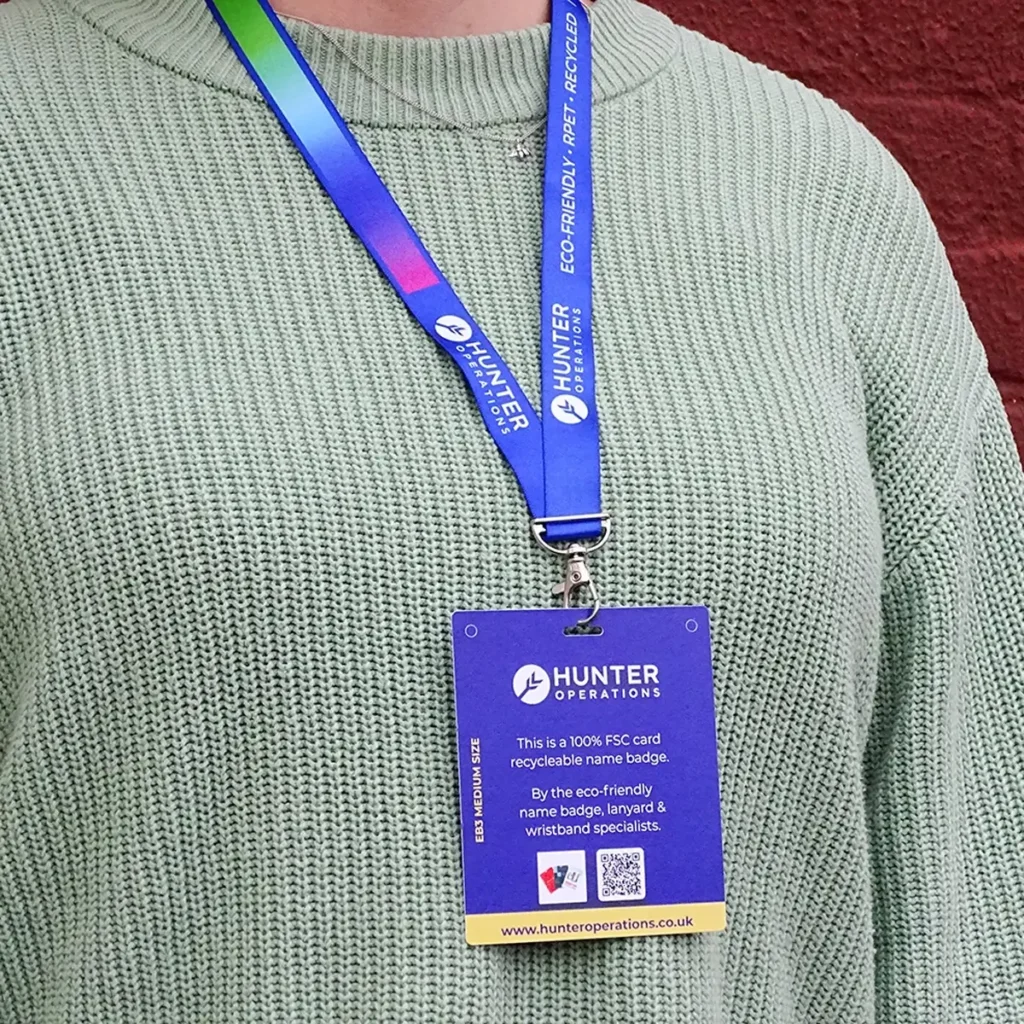At Hunter Operations, we’ve seen it all — from incorrect artwork formats to delivery panic the day before a major exhibition.
To help you get it right the first time and improve your pre-event planning, here’s a comprehensive guide to the five most common mistakes when ordering custom event badges, along with clear advice on how to avoid them. Whether you’re ordering for a local workshop or an international trade show, these tips will ensure your badges arrive on time, on budget, and perfectly suited to your event.
Mistake 1: Leaving It Too Late
The Problem
One of the most frequent issues we encounter is timing. Event planners often underestimate how long it takes to proof, print, assemble, and dispatch high-quality custom badges — especially if you’re including extra features like barcodes, variable data, eco materials, or branded lanyards.
In a rush, mistakes can happen:
- Misspelled names or titles
- Wrong sizes or layouts
- Insufficient time for reprints if something goes wrong
Why It Happens
Badges are often left to the last minute because other tasks (venue, catering, ticketing) take priority. However, badges are often the first physical touchpoint attendees encounter — and they reflect your brand.
The Solution
Plan badge ordering 3 – 4 weeks in advance for printed card badges, and longer for reusable or seed paper options.
Create a checklist:
- Final delegate list deadline
- Artwork approval deadline
- Lanyard matching required?
- Delivery deadline with buffer
Choose a supplier like Hunter Operations that can offer flexible print windows — but don’t rely on express services unless absolutely necessary. A rushed badge order rarely turns out flawless.
Mistake 2: Supplying Poor Artwork or Data
The Problem
You’ve got a great logo and an event colour palette — but if your artwork is low resolution or the data for names/titles isn’t correctly formatted, it could delay your order or result in subpar print quality.
Common Data Issues:
- Names in all caps or all lowercase
- Job titles or companies missing
- Inconsistent column formatting (e.g., First Name and Last Name combined)
- Excel sheets saved as PDFs or copied into emails
Common Artwork Mistakes:
- JPEG or PNG files at 72dpi
- No bleed or crop marks for print files
- Logos with white boxes or pixelation
The Solution
Artwork: Provide vector files (AI, EPS, or SVG) or high-resolution PDF. Ensure fonts are embedded or outlined.
Data:
- Use a clean Excel or Google Sheet
- Separate columns for Name, Job Title, Organisation, and any access levels or colour coding
- Double check spelling before sending
- Avoid merging cells or using special characters
Request a proof from your supplier before going to print — and allow time for sign-off.
Mistake 3: Choosing the Wrong Badge Material or Size
The Problem
Badge material and size affect more than just cost — they impact durability, environmental impact, print quality, and even attendee comfort. Choosing the wrong option can mean smudged names, bent corners, or waste that conflicts with your sustainability goals.
Typical Badge Options:
- Card (FSC-certified) – Affordable, recyclable, good for single use
- Seed Paper – Plantable, eco-friendly, perfect for green events
- Wood / Bamboo – Premium look and reusable, but heavier
- Reusable Plastic with Insert – Durable and ideal for staff or multi-day events
The Mistake
Many organisers default to laminated PVC or generic plastic — only to discover that attendees bin them, they’re hard to recycle, or they don’t reflect the event’s values.
The Solution
Ask your supplier about eco alternatives that match your budget and values.
At Hunter Operations, we offer:
- FSC-certified card in multiple sizes
- Seed paper badges with wildflower seeds
- Wooden and cork options
- Fully recyclable holders for reusable inserts
Also consider:
- Portrait or landscape layout?
- Will QR codes or barcodes be scanned?
- Is print legibility affected by badge size?
Mistake 4: Forgetting About Badge Accessories
The Problem
You’ve approved the badge design — but what about how it’s worn? Lanyards, clips, and holders are often treated as an afterthought. This leads to mismatches in colour, delays in fulfilment, or awkward attachments on the day.
Why It Matters
The badge itself is just one part of a functional ID system. Accessories influence:
- How the badge is worn
- Whether it flips, spins, or stays upright
- Whether it’s easy to scan or see
Typical Oversights:
- Ordering badges with no punched hole or slot for lanyards
- Choosing plastic clips that don’t align with sustainability efforts
- Forgetting lanyard lengths or breakaway requirements for safety
The Solution
Think holistically. Match your badge choice with the right accessory:
- Eco Lanyards – RPET (recycled plastic), bamboo, or paper options
- Metal Clips – Recyclable and robust
- Safety Breakaways – Important for public events and schools
- Printed Lanyards – A powerful branding opportunity!
Speak to your supplier about pre-assembly so badges arrive ready to hand out — saving your team hours of manual prep.
Mistake 5: Not Communicating Badge Requirements Clearly
The Problem
Miscommunication is a silent killer of good badge projects. If you’re unclear with your supplier about event type, delegate mix, printing needs, or delivery logistics, they can’t deliver what you truly need.
Common Miscommunications:
- Not specifying variable data (e.g. different roles or access levels)
- Assuming the supplier knows which side the hole punch should go
- Forgetting to mention international delivery timelines
- Not indicating which badges are for staff, VIPs, or delegates
The Solution
When placing your order, clearly brief your supplier:
- Event name, dates, and location
- Quantity breakdown by type
- Print specifications (single/double-sided, variable data, colour)
- Sustainability goals (e.g. plastic-free, recyclable, seed paper)
- Packing instructions (e.g. sort alphabetically, by day, or by access level)
- Delivery deadline and address (venue or office)
A great supplier will prompt you with the right questions — but the more proactive you are, the smoother the process.
Bonus Tip: Consider Future-Proofing
More events are now seeking sustainable accreditation or aiming for carbon neutrality. Choosing badges and accessories that support those goals isn’t just good for the planet — it’s good for business.
Consider:
- Adding a note to the badge: “Please recycle me” or “Plant me after the event!”
- Using lanyards made from recycled bottles with matching messaging
- Highlighting your sustainable choice in delegate packs and signage
Small details create big impressions.
Final Thoughts: Make Your Badges Work Harder
Badges aren’t just practical — they’re a branding opportunity, a sustainability statement, and an attendee experience enhancer.
Getting the details right can:
- Boost brand perception
- Improve on-site efficiency
- Reduce waste and cost
- Support your event’s messaging and values
At Hunter Operations, we specialise in helping organisations avoid these common pitfalls. From FSC-certified cards and seed paper badges to reusable holders, eco lanyards, and full pre-assembly, we make badge ordering simple, sustainable, and stress-free.






